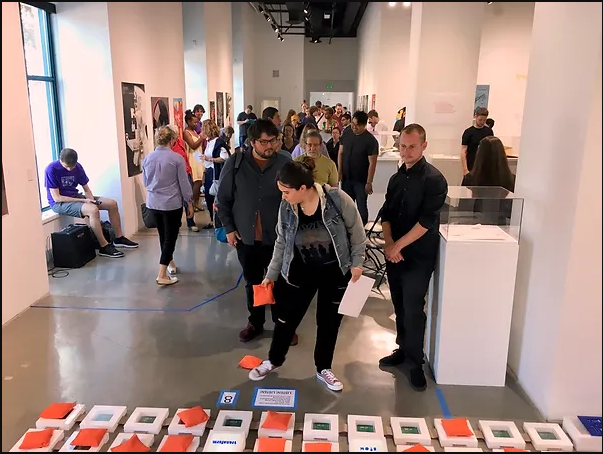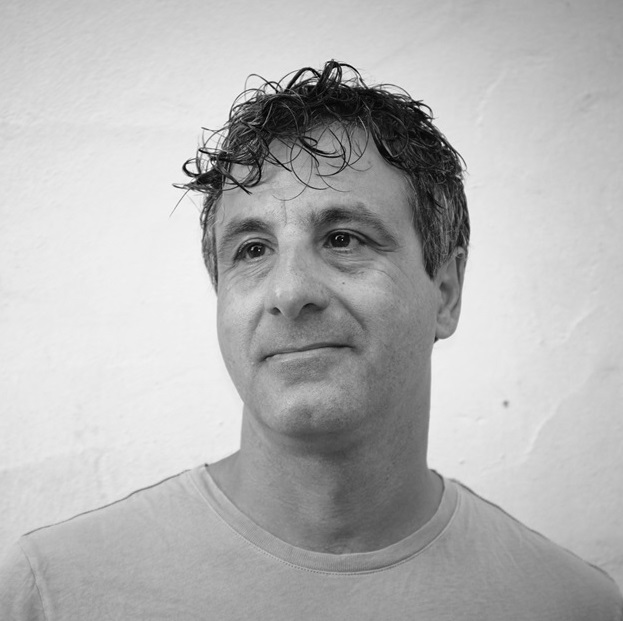Post
The Solitude of the Multitudes | Marco Buongiorno Nardelli
Music is not just an accompaniment. It sounds like a trivial statement, but it is only fair to point out how in the multidiscipliary works that characterize digital art, where technological skills, artistic sensibilities and scientific knowledge are intertwined in truly inextricable and connected ways, music plays a median role of enormous importance, which, by the way, it has always had in the performing arts and multimedia.
And that is why the interview theat you will read with Marco Buongiorno Nardelli, the composer of the electroacoustic work La Solitudine delle Moltitudini (The Solitude of the Multitudes) that permeates Albert Laszlo Barabasi’s exhibition in the Immersive Room with sound, seems to us more than pertinent, and a fundamental testimony to fully understand the exhibited work of which it is a part.

The “miniature opera” Unknown, A Journey, by composer Marco Buongiorno Nardelli. An example of the compositional practice that invests the audience in the creation of the work through interaction with a musical installation (https://www.materialssoundmusic.com/unknown).
MEET – Technology has a long history with your work, we can say that you have always experimented with its relationship with music.
In your latest work that we present here at MEET you enhance the weaving of your music thanks to generative algorithms that composed the sound material of your work.
Is this the first time you have used an AI? Did you adopt it right away or did you go through a cautious “approach path” to such a complex technology?
MBN – So, if by AI we broadly mean the use of computers as a fundamental element of a creative activity, then I would say that all my artistic and scientific production is based on the synergy between mind and computer, which I consider a fundamental extension of my brain. But if by AI we strictly mean “machine learning” algorithms, then I would say that my path is completely orthogonal to the latter. So in my case I would talk more about computer-aided creation/composition or made through programs that progressively take over the role of traditional sheet music. And this happens not only in pieces like “The Solitude of the Multitudes,” which I call an “electroacoustic cantata on a fixed medium,” thus without performers, but also in pieces for instrumentalists and ensembles.
The path between music and technology in my case has an ancient history: I began studying music when I was six years old, and ever since, thanks to the teachings of Mo. Pablo Colino at the Accademia Filarmonica Romana, my most important teacher, I learned that music was made of numbers, and that numbers could be music. And this principle has guided me over the years to bring together the duality of science and art that is the foundation of my work. The fascination with algorithm and programming is also the basis of my activities as a scientist: in fact, I am a computational physicist who develops theories, algorithms and codes for the study of material properties. But that is another story.
MEET – Can we talk about co-creation between artist and algorithm? What does a composer give up and what is he or she enriched with?
MBN – In my case I fully claim my role as composer, the main creator of the final product. My “scores” are programs of thousands of lines of instructions in Python that use libraries of algorithms I have developed over the years (an example is my musicntwrk library, which can be downloaded for free from www.musicntwrk.com). Every musical tradition is founded on algorithms of various kinds, think for example of harmonic progressions in Western music. So as a composer I see only tremendous enrichment in the possibility of generating musical algorithms that would not be possible to solve with the human mind alone. If we talk about co-creation, on the other hand, I always try to give creative freedom to the performers, beyond the simple sonic interpretation of symbols on a staff. And this concept of co-creation often extends to the audience itself, which in many of my works is invested with compositional responsibilities. Such is the case with my multimedia musical installations, which, along with my other works can be heard and viewed on my website: www.materialssoundmusic.com.
MEET – Is the relationship with Barabasi a meeting of method (from theories of complexity and big data analysis tools to the structure of music) or a commonality of aesthetic and artistic vision?
MBN – Lažlo and I work on parallel planes. Obviously his influence as one of the most prominent network scientists is undeniable in the development of my theories on the interpretation of musical spaces as complex systems that can be represented as networks. In particular, since many of these representations follow precisely the typology of the so-called Barabasi and Albert networks, characterized by a combination of a few “central” nodes with many connections and a multitude of peripheral nodes with few connections: the famous “hubs” structure that is characteristic of so many networks representing real systems. I would say that with Lažlo we met on an aesthetic and artistic level and found a commonality of purpose. This exhibition at MEET is our second collaboration in just over a year, and we only met in December 2021!
MEET – Listening to your music, I was immediately reminded of Douglas Hofstadter’s GEB* and his research of the structures and processes of mind, we can also say the hardware and software of intelligence. If artificial intelligence cooperates with artistic creativity, can music conversely contribute to the understanding of intelligence processes? Or is it a one-way path?
MBN – Music is a common feature of all human societies, a unique feature whose evolutionary function is a matter of debate: why do we have music? Centered around this question is the work I do as an external professor at the Santa Fe Institute (www.santafe.edu), an international institute for the study of complex systems. Ours is an interdisciplinary working group that brings together music theorists and composers, physicists and mathematicians, psychologists and neuroscientists in the search for an answer. If I were not convinced of the profound significance of music in the processes of intelligence, I would not be here…
MEET – Lastly, in The Solitude of Multitudes there is a deep relationship with Barabasi’s work displayed in the immersive room.
Like other artistic collaborations between images and music, yours also thrives on a strong harmony, we could almost say a complicity between the authors. What is Barabasi’s contribution to your work, and vice versa?
MBN – Lažlo’s contribution is focused on the conception and aesthetic realization of the “story” told in the video: an imaginary journey that takes us from the initial simplicity of two points coming together, to the complexity of the networks represented in the last part of the video. His artistic vision is translated into image by two fantastic video artists, Alice Grishchenko and Gabor Kitzinger, with an abundance of “hidden” details that make the video work coherent not only visually, but also conceptually. My composition follows this same philosophical vision, but without “copying” or trivializing the process or gesture. I conceived “The Solitude of the Multitudes” as a secular cantata that can live a life of its own, abstracted from the image or context, using the lyrics and the beautiful voice of Júlia Coelho
The work
The Solitude of the Multitudes, electroacoustic cantata for 16 female voices on fixed media (10 audio channels) by Marco Buongiorno Nardelli for the exhibition “The Art of Connection” at the MEET Digital Cultures Center in Milan, Italy, February 2023. Soprano and lyrics: Júlia Coelho
This electroacoustic musical composition follows a strict electronic score, produced by generative composition software that mixes the sound material into an infinite combination of possibilities. The score is composed of graphs formed by a set of nodes connected by directional paths. Each node contains specific information about the type of gesture the system will perform and is made in response to the images in the immersive video. Once a single graph is executed, a new one is generated, making the performance virtually infinite without presenting the same material more than once. Graphs are constructed using various mathematical models along a path that culminates in the model for generating scale-free networks discovered by Barabasi in 1999: the model incorporates two important general concepts, growth and preferential attachment: growth means that the number of nodes in the network increases over time; preferential attachment means that the more connected a node is (the higher its “degree” is), the more likely it is to receive new connections. Nodes with a higher degree have a greater ability to increase the number of their connections with new nodes added to the network. The resulting topology is fundamental in the analysis of many real-world networks, including networks that represent the evolution of musical compositions, a concept that underlies Marco Buongiorno Nardelli’s compositional practice.
The author
Marco Buongiorno Nardelli is a composer and computational physicist at the University of North Texas, where he is Regents Professor and member of iARTA, the “Initiative for Advanced Research in Technology and the Arts,” and CEMI, the “Center for Experimental and Intermediate Music.” Marco is also an External Professor at the Santa Fe Institute, where he directs a program on “Music and Complexity.” As an artist and scientist, his research is inherently interdisciplinary and cross-disciplinary: his work in physics and art is a natural extension of his practices as a creative thinker: “Basically, I’m doing the same thing; the tools I use to achieve the end goals are different, of course, but the conceptual framework is very similar. These two things talk to each other at a very deep level.” As a music theorist and composer, he is a pioneer in the application of complexity theories and big data analysis tools to the structure of music as a generalized mathematical space. As an artist, he is internationally recognized for his music/new media compositions and installations, and his artistic research is rooted in the duality of “music as data, data as music,” including the translation of scientific data and processes into sound material for artistic and creative purposes. More information about Marco’s music can be found at http://www.materialssoundmusic.com

Marco Buongiorno Nardelli (photo credit : Bruno Buongiorno Nardelli, Gerry Images)
